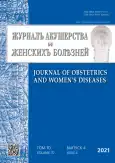NAT2 and CYP1B1 genetic polymorphisms in patients with genital endometriosis depending on tolerability of melatonin
- Authors: Ivashchenko T.E.1, Yarmolinskaya M.I.1,2, Tkhazaplizheva S.S.1
-
Affiliations:
- Research Institute of Obstetrics, Gynecology and Reproductology named after D.O. Ott
- North-Western State Medical University named after I.I. Mechnikov
- Issue: Vol 70, No 4 (2021)
- Pages: 35-42
- Section: Original study articles
- URL: https://journals.rcsi.science/jowd/article/view/51149
- DOI: https://doi.org/10.17816/JOWD51149
- ID: 51149
Cite item
Abstract
BACKGROUND: Genital endometriosis is one of the most pressing problems of modern gynecology. Melatonin is a promising drug with a potentially curative effect on endometriosis.
AIM: The aim of this study was to conduct a comparative analysis of the genetic polymorphism of some genes encoding enzymes involved in melatonin metabolism.
MATERIALS AND METHODS: The genetic polymorphism in the NAT2 and CYP1B1 genes encoding enzymes involved in melatonin metabolism in patients with different tolerance to this drug was analyzed by PCR-RFLP analysis.
RESULTS: In patients with genital endometriosis, the presence of a wild-type allele (N) of the NAT2 gene was associated with poor tolerance of melatonin. The NAT2 (N / N) rapid acetylator phenotype combined with the low catalytic activity of CYP1B1 (C / C) occurred more frequently in endometriosis patients having poor melatonin tolerability compared to the group of patients who tolerated the therapy well.
CONCLUSIONS: For patients with genital endometriosis with the wild-type (N) allele of the NAT2 gene, melatonin administration is inappropriate due to numerous side effects during the drug use.
Keywords
Full Text
##article.viewOnOriginalSite##About the authors
Tatyana E. Ivashchenko
Research Institute of Obstetrics, Gynecology and Reproductology named after D.O. Ott
Email: tivashchenko2011@mail.ru
ORCID iD: 0000-0002-8549-6505
Scopus Author ID: 7004724202
Dr. Sci. (Biol.), Professor, Department of Molecular Medicine
Russian Federation, 3 Mendeleevskaya Line, Saint Petersburg, 199034Maria I. Yarmolinskaya
Research Institute of Obstetrics, Gynecology and Reproductology named after D.O. Ott; North-Western State Medical University named after I.I. Mechnikov
Email: m.yarmolinskaya@gmail.com
ORCID iD: 0000-0002-6551-4147
SPIN-code: 3686-3605
Scopus Author ID: 7801562649
ResearcherId: P-2183-2014
MD, Dr. Sci. (Med.), Professor, Professor of the Russian Academy of Sciences
Russian Federation, 3 Mendeleevskaya Line, Saint Petersburg, 199034; 41 Kirochnaya Str., Saint Petersburg, 191015Saimat S. Tkhazaplizheva
Research Institute of Obstetrics, Gynecology and Reproductology named after D.O. Ott
Author for correspondence.
Email: saim86@yandex.ru
MD, Graduate student in the Department of endocrinology of reproduction
Russian Federation, 3 Mendeleevskaya Line, Saint Petersburg, 199034References
- Vanhie A, Tomassetti C, Peeraer K, et al. Challenges in the development of novel therapeutic strategies for treatment of endometriosis. Expert Opin Ther Targets. 2016;20(5): 593–600. doi: 10.1517/14728222.2016.1118461
- Yarmolinskaya MI, Aylamazyan EK. Genital’nyy endometrioz. Razlichnye grani problem. Saint Petersburg: Eko-vektor; 2017. (In Russ.)
- Adamjan LV, Andreeva EN, Apolihina IA, et al. Jendometrioz: diagnostika, lechenie i reabilitacija: klinicheskie rekomendacii. Moscow; 2013. (In Russ.). [cited 2021 May 5]. Available from: https://moniiag.ru/wp-content/uploads/2019/07/Endometrioz-diagnostika-i-lechenie.pdf
- Rapoport SI, Golichenkov VA, editors. Melatonin: teoriya i praktika. Moscow: Medpraktika-M; 2009. (In Russ.)
- Tenorio F, Simões Mde J, Teixeira VW, Teixeira ÁA. Effects of melatonin and prolactin in reproduction: review of literature. Rev Assoc Med Bras. 2015;61(3):269–747. doi: 10.1590/1806-9282.61.03.269
- Yang HL, Zhou WJ, Gu CJ, et al. Pleiotropic roles of melatonin in endometriosis, recurrent spontaneous abortion, and polycystic ovary syndrome. Am J Reprod Immunol. 2018;80(1):e12839. doi: 10.1111/aji.12839
- Alpay Z, Saed GM, Diamond MP. Female infertility and free radicals: potential role in adhesions and endometriosis. J Soc Gynecol Investig. 2006;13:390–398. doi: 10.1016/j.jsgi.2006.05.002
- Menéndez-Menéndez J, Martínez-Campa C. Melatonin: an anti-tumor agent in hormone-dependent cancers. Int J Endocrinol. 2018;2018:30. doi: 10.1155/2018/3271948
- Bondy SC, Campbell A. Mechanisms underlying tumor suppressive properties of melatonin. Int J Mol Sci. 2018;19(8):e2205. doi: 10.3390/ijms19082205
- Ostjen CA, Rosa CGS, Hartmann RM, et al. Anti-inflammatory and antioxidant effect of melatonin on recovery from muscular trauma induced in rats. Exp Mol Pathol. 2019;106:52–59. doi: 10.1016/j.yexmp.2018.12.001
- Ness TJ. Not always lost in translation. Pain. 2013;154(6):775. doi: 10.1016/j.pain.2013.03.022
- Yarmolinskaya MI, Tkhazaplizheva SSh, Molotkov AS, et al. Effectiveness of melatonin in the treatment of surgically induced endometriosis in rats. Problemy reprodukcii. 2018;24(5):33–40. (In Russ.). doi: 10.17116/repro20182405133
- Patent RUS No. 2693050, MPK A61K31/4045, A61P15/0. No. 2018132521; zajavl. 11.09.2018; opubl. 01.07.2019 Bjul. No. 19. Jarmolinskaja MI, Molotkov AS, Thazaplizheva SSh. Sposob lechenija naruzhnogo genital’nogo jendometrioza. (In Russ.). [cited 2021 May 5]. Available from: https://patenton.ru/patent/RU2693050C1.pdf
- Sambrook J, Fritsch EP, Maniatis T. Molecular cloning: a laboratory. NY: Coldspring Harbour; 1989.
Supplementary files







